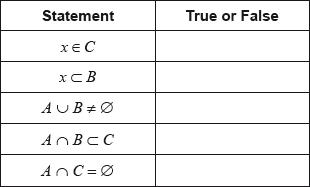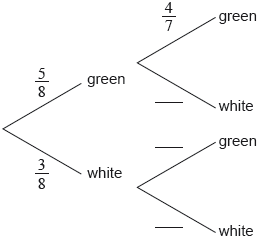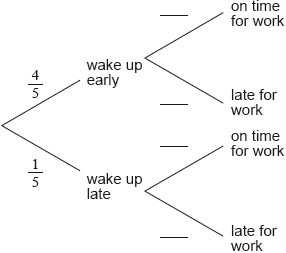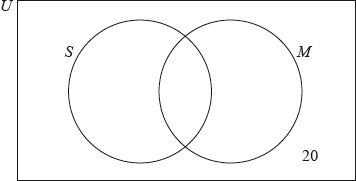| Date | November 2021 | Marks available | 1 | Reference code | 21N.2.SL.TZ0.5 |
| Level | Standard Level | Paper | Paper 2 | Time zone | Time zone 0 |
| Command term | Find | Question number | 5 | Adapted from | N/A |
Question
Arianne plays a game of darts.
The distance that her darts land from the centre, , of the board can be modelled by a normal distribution with mean and standard deviation .
Find the probability that
Each of Arianne’s throws is independent of her previous throws.
In a competition a player has three darts to throw on each turn. A point is scored if a player throws all three darts to land within a central area around . When Arianne throws a dart the probability that it lands within this area is .
In the competition Arianne has ten turns, each with three darts.
a dart lands less than from .
a dart lands more than from .
Find the probability that Arianne throws two consecutive darts that land more than from .
Find the probability that Arianne does not score a point on a turn of three darts.
Find the probability that Arianne scores at least points in the competition.
Find the probability that Arianne scores at least points and less than points.
Given that Arianne scores at least points, find the probability that Arianne scores less than points.
Markscheme
Let be the random variable “distance from ”.
(M1)(A1)
[2 marks]
A1
[1 mark]
(M1)
A1
[2 marks]
(M1)
A1
[2 marks]
METHOD 1
let be the random variable “number of points scored”
evidence of use of binomial distribution (M1)
(A1)
. A1
METHOD 2
let be the random variable “number of times a point is not scored”
evidence of use of binomial distribution (M1)
(A1)
A1
[3 marks]
(M1)
A1
Note: Award M1 for a correct probability statement or indication of correct lower and upper bounds, and .
[2 marks]
(M1)
A1
[2 marks]
Examiners report
Candidates appeared well prepared for straightforward questions using the normal distribution. Most were able to earn marks through recognition of the compound probability event in part (b). The wording of the information in part (c) required careful thought. This acted as a clear discriminator, causing difficulty for most candidates. One common error in this part was the calculation . Though at the end of the paper, it was pleasing to see many candidates identify the event in part (d) as binomial. A common error was the use of . It is recommended that candidates write down the distribution with associated parameters and support this with a probability statement. This will allow method and follow-through marks to be awarded in subsequent parts. Weaker candidates incorrectly used as the upper bound. Those who made it to the end of the paper were often rewarded for correct division of their probabilities found in parts (d)(i)&(ii).
Candidates appeared well prepared for straightforward questions using the normal distribution. Most were able to earn marks through recognition of the compound probability event in part (b). The wording of the information in part (c) required careful thought. This acted as a clear discriminator, causing difficulty for most candidates. One common error in this part was the calculation . Though at the end of the paper, it was pleasing to see many candidates identify the event in part (d) as binomial. A common error was the use of . It is recommended that candidates write down the distribution with associated parameters and support this with a probability statement. This will allow method and follow-through marks to be awarded in subsequent parts. Weaker candidates incorrectly used as the upper bound. Those who made it to the end of the paper were often rewarded for correct division of their probabilities found in parts (d)(i)&(ii).
Candidates appeared well prepared for straightforward questions using the normal distribution. Most were able to earn marks through recognition of the compound probability event in part (b). The wording of the information in part (c) required careful thought. This acted as a clear discriminator, causing difficulty for most candidates. One common error in this part was the calculation . Though at the end of the paper, it was pleasing to see many candidates identify the event in part (d) as binomial. A common error was the use of . It is recommended that candidates write down the distribution with associated parameters and support this with a probability statement. This will allow method and follow-through marks to be awarded in subsequent parts. Weaker candidates incorrectly used as the upper bound. Those who made it to the end of the paper were often rewarded for correct division of their probabilities found in parts (d)(i)&(ii).
Candidates appeared well prepared for straightforward questions using the normal distribution. Most were able to earn marks through recognition of the compound probability event in part (b). The wording of the information in part (c) required careful thought. This acted as a clear discriminator, causing difficulty for most candidates. One common error in this part was the calculation . Though at the end of the paper, it was pleasing to see many candidates identify the event in part (d) as binomial. A common error was the use of . It is recommended that candidates write down the distribution with associated parameters and support this with a probability statement. This will allow method and follow-through marks to be awarded in subsequent parts. Weaker candidates incorrectly used as the upper bound. Those who made it to the end of the paper were often rewarded for correct division of their probabilities found in parts (d)(i)&(ii).
Candidates appeared well prepared for straightforward questions using the normal distribution. Most were able to earn marks through recognition of the compound probability event in part (b). The wording of the information in part (c) required careful thought. This acted as a clear discriminator, causing difficulty for most candidates. One common error in this part was the calculation . Though at the end of the paper, it was pleasing to see many candidates identify the event in part (d) as binomial. A common error was the use of . It is recommended that candidates write down the distribution with associated parameters and support this with a probability statement. This will allow method and follow-through marks to be awarded in subsequent parts. Weaker candidates incorrectly used as the upper bound. Those who made it to the end of the paper were often rewarded for correct division of their probabilities found in parts (d)(i)&(ii).
Candidates appeared well prepared for straightforward questions using the normal distribution. Most were able to earn marks through recognition of the compound probability event in part (b). The wording of the information in part (c) required careful thought. This acted as a clear discriminator, causing difficulty for most candidates. One common error in this part was the calculation . Though at the end of the paper, it was pleasing to see many candidates identify the event in part (d) as binomial. A common error was the use of . It is recommended that candidates write down the distribution with associated parameters and support this with a probability statement. This will allow method and follow-through marks to be awarded in subsequent parts. Weaker candidates incorrectly used as the upper bound. Those who made it to the end of the paper were often rewarded for correct division of their probabilities found in parts (d)(i)&(ii).
Candidates appeared well prepared for straightforward questions using the normal distribution. Most were able to earn marks through recognition of the compound probability event in part (b). The wording of the information in part (c) required careful thought. This acted as a clear discriminator, causing difficulty for most candidates. One common error in this part was the calculation . Though at the end of the paper, it was pleasing to see many candidates identify the event in part (d) as binomial. A common error was the use of . It is recommended that candidates write down the distribution with associated parameters and support this with a probability statement. This will allow method and follow-through marks to be awarded in subsequent parts. Weaker candidates incorrectly used as the upper bound. Those who made it to the end of the paper were often rewarded for correct division of their probabilities found in parts (d)(i)&(ii).





